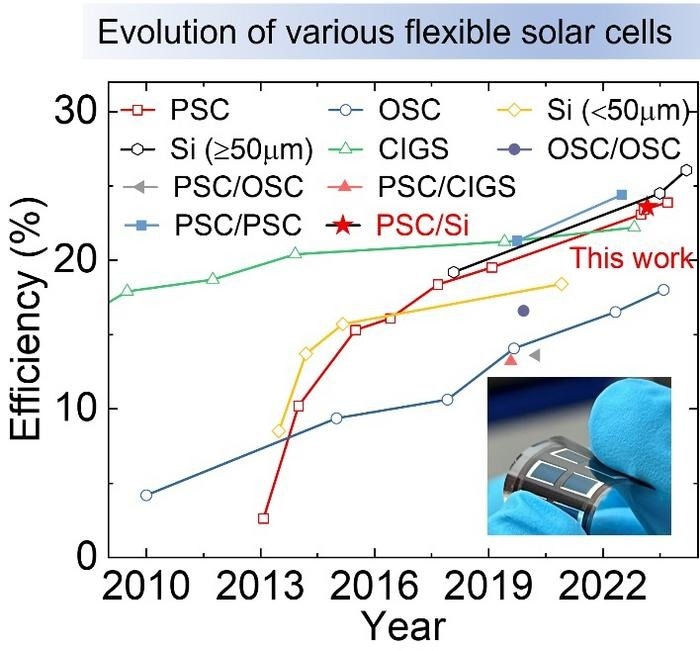The first flexible perovskite/silicon tandem solar cell based on ultrathin silicon, with a thickness of about 30 µm, was successfully demonstrated by the research team from the Ningbo Institute of Materials Technology and Engineering, Chinese Academy of Sciences. The groundbreaking study was published in Science Bulletin.

Evolution of various flexible single-junction and tandem solar cells. Image Credit: Science China Press
Despite the huge amount of progress that has been made in rigid perovskite/silicon tandem solar cells, with reported efficiencies reaching up to 33.9 %, the utilization of flexible perovskite/silicon tandem solar cells has remained elusive. This challenge arises from the complexity of enhancing light absorption in ultrathin silicon bottom cells while maintaining their mechanical flexibility.
In their research, the team successfully demonstrated the first flexible perovskite/silicon tandem solar cell based on ultrathin silicon, approximately 30 µm thick. By reducing wafer thicknesses and adjusting the feature sizes of light-trapping textures, they significantly enhanced the flexibility of the silicon substrate without compromising light utilization. Furthermore, by capping the perovskite top cells, they improved the mechanical durability of the device, addressing concerns related to fractures on the silicon surface.
The resulting flexible perovskite/silicon tandem solar cell achieved a certified stable efficiency of 22.8 %, setting a record for flexible solar cells. Additionally, with an exceptional power-to-weight ratio of 3.12 W g−1, the device offers high performance in a lightweight package. Remarkably, the flexible tandems exhibited outstanding bending durability, maintaining 98.2 % of their initial performance even after 3,000 bending cycles at a radius of only 1 cm.
In summary, the development of flexible photovoltaic technology has advanced significantly with the breakthrough made by Professor Jichun Ye and his colleagues. Their study not only shows that flexible perovskite/silicon tandem solar cells are feasible but also creates new opportunities for lightweight, highly efficient solar cells to be utilized in a variety of applications.
Journal Reference:
Wang, X., et al. (2024) Ultrathin (∼30 µm) flexible monolithic perovskite/silicon tandem solar cell. Science Bulletin. doi:10.1016/j.scib.2024.04.022.